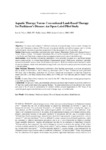Mostrar o rexistro simple do ítem
Aquatic therapy versus conventional land-based therapy for Parkinson's disease: an open-label pilot study
| dc.contributor.author | Vivas-Costa, Jamile | |
| dc.contributor.author | Arias, Pablo | |
| dc.contributor.author | Cudeiro, Javier | |
| dc.date.accessioned | 2015-05-04T11:59:58Z | |
| dc.date.available | 2015-05-04T11:59:58Z | |
| dc.date.issued | 2011 | |
| dc.identifier.citation | Vivas J, Arias P, Cudeiro J. Aquatic therapy versus conventional land-based therapy for Parkinson's disease: an open-label pilot study. Arch Phys Med Rehab. 2011;92(8):1202-10. | es_ES |
| dc.identifier.uri | http://hdl.handle.net/2183/14467 | |
| dc.description.abstract | [Abstract] Objectives: To assess and compare 2 different protocols of physiotherapy (land or water therapy) for people with Parkinson’s disease (PD) focused on postural stability and self-movement, and to provide methodological information regarding progression within the program for a future larger trial. Design: Randomized, controlled, open-label pilot trial. Setting: Outpatients, Parkinson’s disease Center of Ferrol - Galicia (Spain). Participants: Individuals (N 11) with idiopathic PD in stages 2 or 3 according to the Hoehn and Yahr Scale completed the investigation (intervention period plus follow-up). Interventions: After baseline evaluations, participants were randomly assigned to a land-based therapy (active control group) or a water-based therapy (experimental group). Participants underwent individual sessions for 4 weeks, twice a week, for 45 minutes per session. Both interventions were matched in terms of exercise features, which were structured in stages with clear objectives and progression criteria to pass to the next phase. Main Outcome Measures: Participants underwent a first baseline assessment, a posttest immediately after 4 weeks of intervention, and a follow-up assessment after 17 days. Evaluations were performed OFF-dose after withholding medication for 12 hours. Functional assessments included the Functional Reach Test (FRT), the Berg Balance Scale (BBS), the UPDRS, the 5-m walk test, and the Timed Up and Go test. Results: A main effect of both therapies was seen for the FRT. Only the aquatic therapy group improved in the BBS and the UPDRS. Conclusions: In this pilot study, physiotherapy protocols produced improvement in postural stability in PD that was significantly larger after aquatic therapy. The intervention protocols are shown to be feasible and seem to be of value in amelioration of postural stability–related impairments in PD. Some of the methodological aspects detailed here can be used to design larger controlled trials. | es_ES |
| dc.description.sponsorship | Galicia. Consellería de Educación; E04D043802BR | es_ES |
| dc.description.sponsorship | Galicia. Consellería de Innovación, Industria e Comercio; PGIDIT06PXIB137036PR | |
| dc.language.iso | eng | es_ES |
| dc.publisher | Elsevier | es_ES |
| dc.relation.uri | http://dx.doi.org/10.1016/j.apmr.2011.03.017 | es_ES |
| dc.rights | This is the author's version of a work that was accepted for publication in "Archives of Physical Medicine and Rehabilitation". Changes resulting the publishing process, such as peer review, editing, corrections, structural formatting, and other quality control mechanism may not be reflected in this document. Changes may have been made to this work since it was submitted for publication. A definitive version was subsequently published in Elsevier. | es_ES |
| dc.subject | Hydrotherapy | es_ES |
| dc.subject | Parkinson's disease | es_ES |
| dc.subject | Physical therapy modalities | es_ES |
| dc.subject | Rehabilitation | es_ES |
| dc.title | Aquatic therapy versus conventional land-based therapy for Parkinson's disease: an open-label pilot study | es_ES |
| dc.type | info:eu-repo/semantics/article | es_ES |
| dc.rights.access | info:eu-repo/semantics/openAccess | es_ES |
Ficheiros no ítem
Este ítem aparece na(s) seguinte(s) colección(s)
-
GI-NEURO - Artigos [165]






